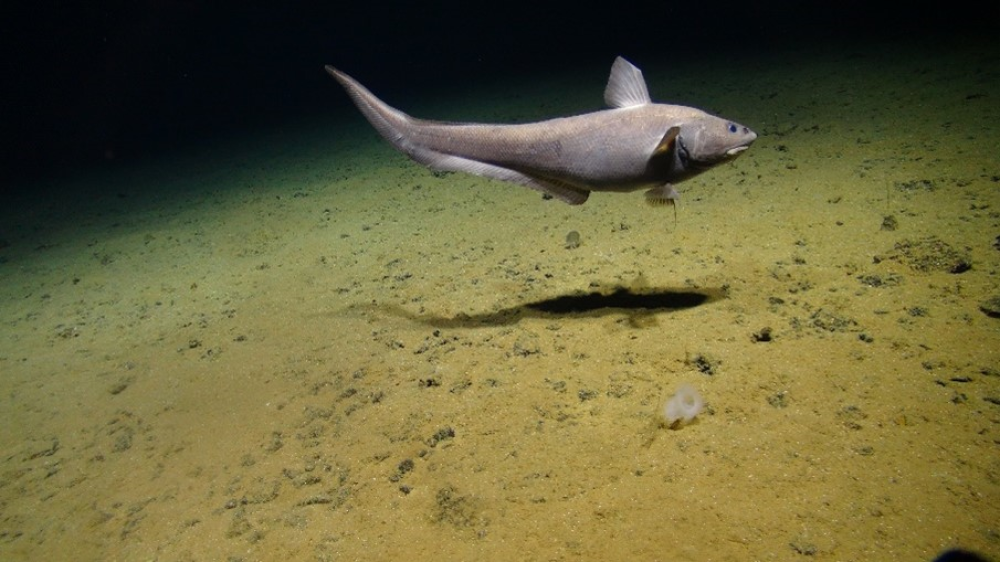Barbie-pink sea pigs, rattail fish, and a unicumber: these were the unexpected stars of a recent expedition into the Clarion-Clipperton Zone (CCZ) where scientists are studying biodiversity. The region’s animal life is of particular interest because it’s also the proposed site of deep-sea mining, being home to a huge volume of “sea potatoes” that contain the precious metals we need for the green revolution.
Amperima “sea pigs” and “unicumbers” were perhaps the most alien of the critters captured on camera by the team led by Dr Adrian Glover, a deep-sea researcher at London’s Natural History Museum (NHM). This included the hot-pink “Barbie pig” whose nickname was coined by Southampton PhD student Bethany Fleming after most of the team watched the movie on the plane to Costa Rica. The curious creatures may even be new-to-science species, making their debut in these first-ever high-definition photos.
“We can assume that many of these species will be new to science,” Regen Drennan, a post-doctoral marine biologist at London NHM, told IFLScience. “Sometimes they have been seen/observed/known before, but not collected or formally described. For example, the sea pig nicknamed the unicumber had been seen in previous seabed imagery surveys, but not collected or imaged in high definition to the best of our knowledge.”
“All the specimens that have been collected will be brought back to the museum, where they will be identified and studied by the researchers here,” added Eva Stewart, also a post-doctoral marine biologist based at the NHM. “Some may be described as new species, and lots of the specimens will be used for research looking at patterns of diversity across the seafloor in this area.”
The team also spotted rattail fish, one of the few vertebrates that can survive at such great depths. The expedition journeyed 4,000-5,000 meters (13,000-16,000 feet) below the surface of the central Pacific as part of the SMARTEX project to explore the CCZ, keeping an eye out for what curious life exists here.
It’s a question of global interest due to the great fields of sea potatoes, also known as deep-sea tubers or manganese nodules, that can be found here. These black rocks don’t look like much, but they are one of the richest-known sources of cobalt, nickel, and manganese on the planet: three things we’re going to need a lot of if we’re going to turn all the planet’s gas-guzzling cars into battery-powered ones.

The “Unicumber”, a see-through sea cucumber.
Image credit: © #NHMDeepSea Group, Natural History Museum, UK
“[Ninety] percent of the world’s exploration contracts for nodules are in the Clarion-Clipperton Zone, which represent less than half of 1 percent of the global seafloor,” The Metals Company PR and Media Manager Rory Usher told IFLScience. “But this represents the largest source of manganese, nickel, and cobalt, anywhere on the planet and that dwarfs everything on land by many orders of magnitude. There are enough metals in situ at two of the sites that would satisfy the needs of 280 million cars, which represents every car in America, or a quarter of the world’s vehicle fleet.”
Deep-sea mining aims to harvest these nodules by scooping them up off the seabed and transporting them to the surface. The motivation to search for these resources on the seabed is that it represents a purer source that would produce less run-off compared to terrestrial mining. It likely also has less biomass per square meter compared to the forests of Indonesia, which is a leading site for mining.
“The distribution of these animals seemed to be quite patchy – the dominant sea cucumber on one ROV dive might be completely absent at another location, with a different one more common,” continued Drennan. “But in terms of density that we are used to, for example on land or shallower marine systems, the deep sea in general (and this area of the CCZ) is characterised by very low population densities, largely because food is so limited at these depths.”

Rattail fish, one of the few vertebrates that can survive at these depths.
Image credit: © #NHMDeepSea Group, Natural History Museum, UK
“Therefore, even when we discuss a ‘dominant’ species, this is still at relatively low numbers. What will be important to understand is the presence of species over large spatial scales, and connectivity between populations across these large scales.”
Before we can start scooping up these precious potatoes, much research needs to be done to establish if disturbing the seabed and creating sediment plumes in this otherwise pristine environment could have a negative influence on the survival of wildlife and ecosystems. That’s one of the things SMARTEX – aka, Seabed Mining and Resilience to Experimental Impact – hopes to ascertain.
Source Link: "Barbie Pigs" Among Strange And Possibly New-To-Science Species Discovered In The Pacific